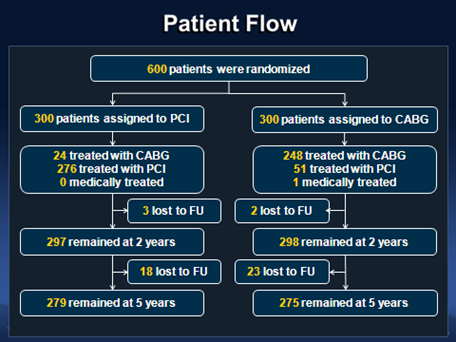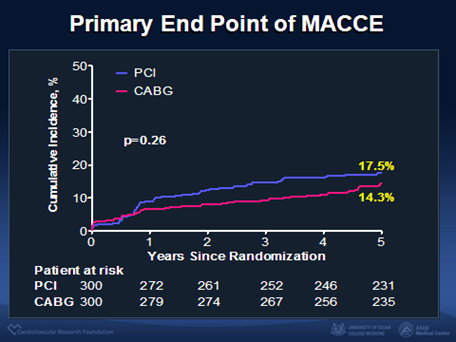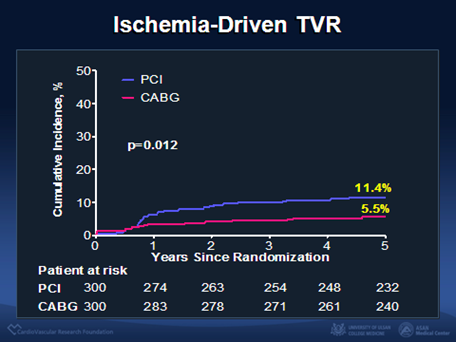PCI vs. CABG for Unprotected Left Main Disease
Coronary artery bypass grafting (CABG) has long been considered the treatment of choice for unprotected left main coronary artery (ULMCA) stenosis, particularly when the internal thoracic artery is used as a conduit. However, given the up-front risks of this procedure, coupled with improvements in percutaneous coronary intervention (PCI) techniques and dramatic advances in stent technology, the primacy of CABG for ULMCA revascularization has been challenged. Several randomized, controlled trials comparing drug eluting stent (DES) implantation with CABG surgery for ULMCA stenosis have been published in recent years.1-3 These have demonstrated that the short-term results with PCI with respect to hard clinical endpoints are similar to those encountered with CABG. However, the potential benefits of CABG over PCI might take many years to appear, insofar as the major theoretical advantage of CABG is that it treats both the current disease as well as disease that may develop later within the same distribution. Therefore, long-term follow up of these randomized trials is essential in order in determine the true risk-benefit tradeoff between CABG and PCI for ULMCA disease.
|
In this regard, the five-year results of the Premier of Randomized Comparison of Bypass Surgery versus Angioplasty Using Sirolimus-Eluting Stent in Patients with Left Main Coronary Artery Disease (PRECOMBAT) have now been published.4 PRECOMBAT was an open-label trial in which 600 patients with ULMCA stenosis of at least 50% by visual estimation were randomized to undergo PCI with a sirolimus-eluting stent or CABG surgery with an internal thoracic artery graft.[Figure 1] The primary endpoint was a composite death from any cause, myocardial infarction (MI), stroke, or ischemia-driven target vessel revascularization (TVR). At five years, a primary outcome event occurred in 52 patients in the PCI group (17.5%) and 42 patients in the CABG group (14.3%), resulting in a non-significant difference (hazard ratio (HR) 1.27, 95% confidence interval (CI) 0.84 to 1.90, p=0.26).[Figure 2] Whereas the hard clinical endpoint of death, MI, or stroke was similar in the two groups (8.4% vs. 9.6%, HR 0.89, 95% CI 0.52 to 1.52, p=0.66),[Figure 3] TVR was more common among patients assigned to PCI (11.4% vs. 5.5%, HR 2.11, 95% CI 1.16 to 3.84, p=0.012).[Figure 4] Therefore, the authors conclude that PRECOMBAT supports current guidelines stating that LM stenting is a feasible revascularization strategy for patients with suitable coronary anatomy.
Besides these top-line results, other findings of the PRECOMBAT trial deserve comment. First, patients in the PCI group underwent protocol-mandated angiography 8 to 10 months after enrollment. This likely increased the proportion of patients in the PCI group undergoing repeat revascularization at that time point. However, landmark analysis after the first year demonstrated a continued accrual of revascularization procedures in the PCI group above that seen in the CABG group. Given the known durability of internal thoracic artery grafts, this finding is expected. Second, results in both the PCI and CABG groups were superb. Of particular note, the rate of stroke at five years was remarkably low, at 0.7% in both groups, and definite or probable stent thrombosis occurred in only two patients (0.3%) in the PCI cohort. Technical factors that likely contributed to these low event rates were the use of internal thoracic artery grafts in nearly all CABG patients and the use of intravascular ultrasound in nearly all PCI patients. Additionally, there was prolonged use of dual antiplatelet therapy (DAPT) in the PCI group (67.2% at five years). Recent randomized trials have confirmed that the prolonged use of DAPT is associated with a marked reduction in cardiovascular events after drug eluting stent implantation.5,6 On the other hand, statin use was relatively low in both the PCI and CABG groups (approximately 50% at five years), and it is likely that event rates might have been lower still had statins been more widely used.
It is important to note that PRECOMBAT was a study of patients with ULMCA, but not of patients with exclusively LM disease. The majority of patients in the trial had one or more stenosis in addition to the LM stenosis. In the subgroup of patients with LM and 3-vessel coronary disease (n=245), results favored CABG. Although this finding must be considered hypothesis-generating, these results are concordant with other trials of multivessel PCI versus CABG, in which the presence of more extensive coronary disease has been associated with a greater benefit of CABG.7
The totality of the available evidence suggests the following approach to the treatment of patients with ULMCA disease in whom revascularization is planned. In patients with ULMCA disease amenable to PCI in whom prolonged treatment with dual antiplatelet therapy is feasible, PCI with a drug-eluting stent is associated with a rate of hard clinical endpoints similar to that of CABG. Patients should be made aware that the likelihood of requiring a repeat revascularization procedure (about 2% per year) is modestly higher with this strategy. In this scenario, it is likely that most patients would choose to undergo PCI rather than CABG. As the severity of additional coronary stenoses becomes more extensive, and particularly in the presence of diabetes mellitus, CABG with the use of an internal thoracic artery conduit becomes the treatment of choice because of a reduced long-term risk of important clinical events. However, in patients with additional comorbidities associated with increased surgical risk (particularly in the frail elderly), PCI remains a reasonable alternative. As always, patient-centered, individualized decision-making by the patient and the heart team is the strategy most likely to result in the best outcomes.
References
- Seung KB, Park DW, Kim YH et al. Stents versus coronary-artery bypass grafting for left main coronary artery disease. N Engl J Med 2008;358:1781-92.
- Morice MC, Serruys PW, Kappetein AP et al. Outcomes in patients with de novo left main disease treated with either percutaneous coronary intervention using paclitaxel-eluting stents or coronary artery bypass graft treatment in the Synergy Between Percutaneous Coronary Intervention with TAXUS and Cardiac Surgery (SYNTAX) trial. Circulation 2010;121:2645-53.
- Park SJ, Kim YH, Park DW et al. Randomized trial of stents versus bypass surgery for left main coronary artery disease. N Engl J Med 2011;364:1718-27.
- Ahn J-M, Roh J-H, Kim Y-H et al. Randomized trial of stents versus bypass surgery for left main coronary artery disease: Five-year outcomes of the PRECOMBAT study. J Am Coll Cardiol 2015 (epub before print).
- Mauri L, Kereaikes DJ, Yeh RW et al. Twelve or 30 months of dual antiplatelet therapy after drug-eluting stents. N Engl J Med 2014;371:2155-66.
- Bonaca MP, Bhatt DL, Cohen M et al. Long-term use of ticagrelor in patients with prior myocardial infarction. N Engl J Med 2015 (epub before print).
- Serruys PW, Morice M-C, Kappetein AP et al. Percutaneous coronary intervention versus coronary-artery bypass grafting for severe coronary artery disease. N Engl J Med 2009;360:961-72.
Keywords: Aged, Angiography, Angioplasty, Comorbidity, Confidence Intervals, Constriction, Pathologic, Coronary Artery Bypass, Coronary Artery Disease, Coronary Disease, Coronary Stenosis, Diabetes Mellitus, Drug-Eluting Stents, Follow-Up Studies, Frail Elderly, Humans, Mammary Arteries, Myocardial Infarction, Percutaneous Coronary Intervention, Sirolimus, Stroke, Thrombosis
< Back to Listings




